
HOME
INTRO
SYMBOLS
ALMANAC
ECONOMY
GEOGRAPHY
STATE MAPS
PEOPLE
FORUM
NEWS
COOL SCHOOLS
STATE QUIZ
STATE LINKS
BOOK STORE
MARKETPLACE
GUESTBOOK
CONTACT US


You may double left-click on a word on this page to retrieve its definition. Tweet Follow
Arkansas State Fruit & Vegetable
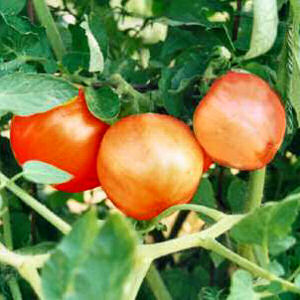
Arkansas State Fruit & Vegetable: South Arkansas Vine Ripe Pink Tomato
Tomatoes are not native to Arkansas, but in the 1920s commercial growers began to grow them in south Arkansas. Then, during the 1950s a fresh-market industry began to grow around Warren in Bradley County (Land of tall pines and pink tomatoes).
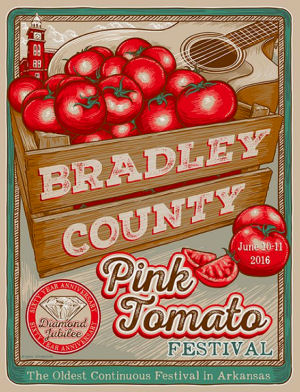
Bradley County Pink Tomato FestivalTM
In 1956 a group of citizens in Warren, the small town in southeastern Arkansas, came together to organize a festival to honor the local tomato crop commonly referred to as the Bradley pink. Lacking a yellow pigment, the Bradley pink was a pink tomato named for Bradley County, one of the principle tomato growing counties in the state.
The small festival, the Bradley County Pink Tomato FestivalTM, continues to this day and is billed as "one of the oldest continuous running festivals in the state of Arkansas." 1 Celebrated on the second full weekend in June, the festival celebrated its 60th year in 2016.
In 1961, the University of Arkansas at Fayetteville released a variety of tomato formally registered as the "Bradley Pink." The Bradley Pink was resistant to fusarium wilt, a soil-borne fungal disease, and sported the distinctive pink color so recognized and revered by Arkansans. Improved varieties followed.
Unfortunately, as the demands of large grocery store chains and expanding and more distant markets increased, Arkansas farmers were forced into providing the red fleshed fruits with the thicker skins and longer ripening times that the markets required. By the mid-eighties most of the south Arkansas farmers had shifted from the pink varieties to red varieties; the "Mountain" varieties developed at North Carolina State University.
It was around this time that the will to promote and re-establish the reputation of the vine-ripened pink tomatoes of Arkansas coalesced into efforts to designate the fruit an official symbol of the state. At the time, Arkansas had already adopted a number of symbols, including an official floral emblem, an official rock, and an official musical instrument, in addition to a state seal and state flag.
The Bradley County Pink Tomato Festival™ had been staged for over thirty years when State Representative John Lipton brought House Bill No. 1480 to the floor of the House of Representatives. Rep. Lipton represented the citizens of Bradley County in the state legislature.
House Bill No. 1480 passed a full vote of the House of Representatives in February, 1987. Rep. Lipton promised 20 pounds of tomatoes to each Representative who voted for the measure. It's not clear to us if Rep. Lipton ever made good on his promise to his colleagues in the House.
After passing in the Arkansas Senate, House Bill No. 1480 was signed into law by Governor Bill Clinton on March 16, 1987. By Act No. 255 of the Regular Session of the 1987 General Assembly of the State of Arkansas, the South Arkansas vine ripe pink tomato was made the official state fruit and the official state vegetable of Arkansas.
State of Arkansas
76th General Assembly
Regular Session, 1987
HOUSE BILL 1480
By: Representative Lipton
"AN ACT TO DESIGNATE THE SOUTH ARKANSAS VINE RIPE PINK TOMATO AS THE STATE FRUIT AND THE STATE VEGETABLE; AND FOR OTHER PURPOSES."
BE IT ENACTED BY THE GENERAL ASSEMBLY OF THE STATE OF ARKANSAS:
SECTION 1. It is hereby found and determined by the General Assembly that the South Arkansas Vine Ripe Pink Tomato has a taste, texture, appearance and aroma second to none, and that the tomato is botanically a fruit and used as a vegetable. It is furthermore determined by the General Assembly that Arkansas does not have a State Fruit or a State Vegetable. Therefore, the South Arkansas Vine Ripe Pink Tomato shall hereafter be the official State Fruit and the official State Vegetable.
SECTION 2. All laws and parts of laws in conflict with this Act are hereby repealed.
APPROVED: 3/16/87
A little more than one half of Arkansas tomato production is provided by the southeastern counties of Bradley, Ashley, and Drew. Today, these tomatoes are overwhelmingly red varieties with slower ripening times and damage resistant thicker skins that are currently demanded by large grocery store chains. However, Arkansans can still find the official state fruit and vegetable at local farmer's markets and produce stands in season. And Arkansans can still enjoy the delicate flavor and texture of their vine-ripened pink tomatoes.
The question always comes up. Why was the tomato made both the official fruit and the official vegetable of Arkansas?
Botanically, the tomato is considered a fruit but consumers commonly think of it and use it as a vegetable. In fact, a ruling by the Supreme Court in 1893 regarding taxation, declared that the tomato could be taxed as a vegetable. Because of conflicting characterizations of the tomato, the sponsoring legislation - House Bill No. 1480 - adopted the South Arkansas Vine Ripe Pink Tomato as both the official state fruit and the official state vegetable of Arkansas. You can read all of the details here.
Presumably, the duel designation would leave no room for argument.
When Ohio designated the tomato as one of their state symbols, legislators adopted it as the official state fruit as did Tennessee.
Louisiana, in a compromise measure, adopted the Creole tomato as their official state vegetable plant and, at the same time, named the sweet potato their official state vegetable.
By the way, in keeping with a somewhat interesting pattern, Louisiana has adopted the strawberry - botanically a berry - as their official state fruit and the Mayhew fruit tree as their official state fruit tree.
Arkansas Law
The following information was excerpted from the Arkansas Code, Title 1, Chapter 4, Section 1-4-115.
Title 1. General Provisions.
Chapter 4. State Symbols, Motto, Etc.
SECTION 1-4-115.
1-4-115. State fruit and vegetable.
It is found and determined by the General Assembly that the South Arkansas Vine Ripe Pink Tomato has a taste, texture, appearance, and aroma second to none and that the tomato is botanically a fruit and used as a vegetable. It is further determined by the General Assembly that Arkansas does not have a state fruit or a state vegetable. Therefore, the South Arkansas Vine Ripe Pink Tomato shall be the official state fruit and the official state vegetable.
History. Acts 1987, No. 255, § 1.
Sources...
"Arkansas Code". Arkansas General Assembly. 2005. 22 April 2005
Associated Press. "Bill To Suspend Retailers' Discount Still In House." The Courier News [Blytheville] 13 Feb. 1987: 5. Print.
Kelly, Debra. The Supreme Court's Difficulty With The Difference Between Fruits And Vegetables.. Jamie Frater, 29 Sept. 2015. Web. 01 Sept. 2016.
Lipton, John. "HB1480 - AN ACT TO DESIGNATE THE SOUTH ARKANSAS VINE RIPE PINK TOMATO AS THE STATE FRUIT AND THE STATE VEGETABLE; AND FOR OTHER PURPOSES." Arkansas State Legislature. State of Arkansas, 16 Mar. 1987. Web. 31 Aug. 2016.
Medders, Howell. "Pink Tomato Wins Arkansas State Titles." The Courier-Index [Marianna] 02 July 1987: 8. Print.
[1]Pressly, Anne. "The State's Oldest Festival: Pink Tomato Festival." KATV Channel 7, Little Rock, Sinclair Broadcast Group, Inc. 10 June 2006. 29 June 2006.
Shearer, Benjamin F. and Barbara S. State Names, Seals, Flags and Symbols: A Historical Guide Third Edition, Revised and Expanded. Westport, Conn: Greenwood Press, 3 Sub edition, 2001.
Ware, David. "Official State Fruit and Vegetable." The Encyclopedia of Arkansas History & Culture. The Central Arkansas Library System, 02 Nov. 2015. Web. 01 Sept. 2016.
Additional Information
Official State Fruit and Fruit & Vegetable: aka: South Arkansas Vine Ripe Pink Tomato. The Encyclopedia of Arkansas History and Culture from the Central Arkansas Library System.
Home Gardening Series: Tomatoes :
University of Arkansas, Division of Agriculture: Cooperative Extension Service.
:
University of Arkansas, Division of Agriculture: Cooperative Extension Service.
Bradley County Pink Tomato Festival: The oldest continuous running festival in Arkansas!
The Fruit of Time: by Paul Greenberg. "Has ever so much deliciousness arrived in so plain a container? A friend keeps leaving treasures for me in a plain brown wrapper. Or sometimes a plastic grocery bag. Paper or plastic, the contents are heavenly."
Bradley County: Bradley County, Arkansas USGenWeb Project Home Page.
State Fruits: Complete list of official state fruits.
State Vegetables: Complete list of official state vegetables.
More symbols & emblems: Complete list of official Arkansas state symbols.

It's Official!
David Ware
It's Official!: The Real Stories behind Arkansas’s State Symbols, by David Ware. 200 pages. Publisher: Butler Center for Arkansas Studies; 1st Edition (September 1, 2015) Distributed by The University of Arkansas Press.
Since Arkansas’s creation as an independent territory in 1819, its legislature has officially designated a wide assortment of symbols. Some of these refer to economic mainstays while others attest to the aspirations of those who saw a bright future for their extensive and varied community. This volume’s essays examine each of Arkansas’s officially designated symbols, outlining their genesis, their significance at the time of their adoption, and their place in modern Arkansas. Combining political narratives, natural history, and the occasional “shaggy dog” story, Ware makes a case for considering the symbols as useful keys to understanding both the Arkansas that has been and the one it hopes to be.
David Ware has served as historian of the Arkansas State Capitol since 2001. He is a native of the District of Columbia, grew up in Nebraska and Wyoming, and earned his PhD in American history from Arizona State University. His career has included both academic and public history, as well as busking and an extended foray in the oil exploration business. He and his wife and daughter live in Little Rock, Arkansas.
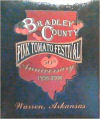
Bradley County Pink Tomato Festival
50th Anniversary Cookbook
All-Tomato
Cookbook Committee
Bradley County Pink Tomato Festival 50th Anniversary Cookbook, by the All-Tomato Cookbook Committee. 336 pages. Publisher: Morris Press Cookbooks (2006) The 50th Anniversary Bradley County Pink Tomato FestivalTM Official Cookbook is available! There are 850 entries in the book and each recipe includes tomatoes as an ingredient.
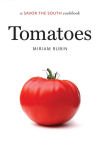
Tomatoes
Miriam Rubin
Tomatoes, by Miriam Rubin. 144 pages. Publisher: The University of North Carolina Press (March 4, 2013) In Tomatoes, Miriam Rubin gives this staple of southern gardens the passionate portrait it deserves, exploring the tomato's rich history in southern culture and inspiring home cooks to fully enjoy these summer fruits in all their glorious variety. Rubin, a prominent food writer and tomato connoisseur, provides fifty vibrant recipes as well as wisdom about how to choose tomatoes and which tomato is right for which dish.
Tomatoes includes recipes that celebrate the down-home, inventive, and contemporary, such as Stand-over-the-Sink Tomato Sandwiches, Spiced Green Tomato Crumb Cake, Green Tomato and Pork Tenderloin Biscuit Pie, and Tomato and Golden Raisin Chutney. Rubin also offers useful cooking tips, lively lessons on history, cultivation, and preserving, and variations for year-round enjoyment of the tomato.
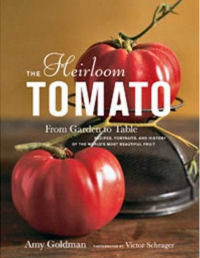
The Heirloom Tomato
by Amy Goldman
The Heirloom Tomato: From Garden to Table, by Amy Goldman. 272 pages. Bloomsbury USA; 1st edition (August 5, 2008) From the world-class garden of acclaimed food writer Amy Goldman, a gorgeously illustrated guide to the world's most beautiful and delicious tomatoes.
From glorious heirloom beefsteaks - that delicious tomato you had as a kid but can't seem to find anymore - to exotica like the ground tomato (a tiny green fruit that tastes like pineapple and grows in a tomatillo-like husk), The Heirloom Tomato is filled with gorgeous shots of tomatoes so luscious they verge on the erotic.
Along with the recipes and photos are profiles of the tomatoes, filled with surprisingly fascinating facts on their history and provenance, and a master gardener's guide to growing your own. More than just a loving look at one of the world's great edibles, this is a philosophy of eating and conservation between covers - an irresistible book for anyone who loves to cook or to garden.

How to Grow
World Record Tomatoes
Charles Wilber
How to Grow World Record Tomatoes: A Guinness Champion Reveals His All-Organic Secrets, by Charles Wilber. 132 pages. Acres U.S.A.; 1st edition (October 1998) Patrons with a love of tomatoes and a competitive nature may enjoy these organic tips from Wilber, who earned a place in the Guinness Book of World Records by coaxing 1,368 pounds of tomatoes from only four plants. This octogenarian's delivery is folksy and no-nonsense as he relates advice on composting, seed selection, pruning, watering, and other basics of tomato gardening.
For most of his 80+ years, Charles Wilber studied how to best work with nature. In How to Grow World Record Tomatoes he tells his personal story and offers his philosophy and approach to gardening. He reveals for the first time how he grows record-breaking tomatoes and produce of every variety. There's no magic involved. Just a well thought out system that gives plants more than they could ever want, and makes it possible for them to reach their full potential. Wilber's compost is the cornerstone along with a wide circumference around plants layered with compost, alfalfa meal and mulch. Valuable pruning and watering details are given, too, as well as a new way of looking at seeds. As you will learn, growing awesome tomatoes integrates every aspect of gardening that you can imagine.
The Omnivore's Dilemma: A Natural History of Four Meals, by Michael Pollan. 464 pages. Penguin Press HC, The (April 11, 2006) The bestselling author of The Botany of Desire explores the ecology of eating to unveil why we consume what we consume in the twenty-first century
In Defense of Food: An Eater's Manifesto, by Michael Pollan. 256 pages. Penguin Press HC, The (2008) In looking toward traditional diets the world over, as well as the foods our families-and regions-historically enjoyed, we can recover a more balanced, reasonable, and pleasurable approach to food. Michael Pollan's bracing and eloquent manifesto shows us how we might start making thoughtful food choices that will enrich our lives and enlarge our sense of what it means to be healthy.

